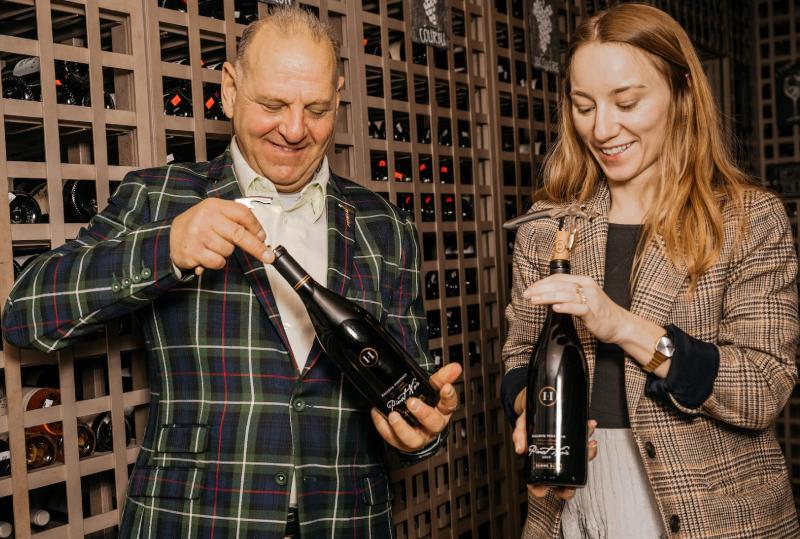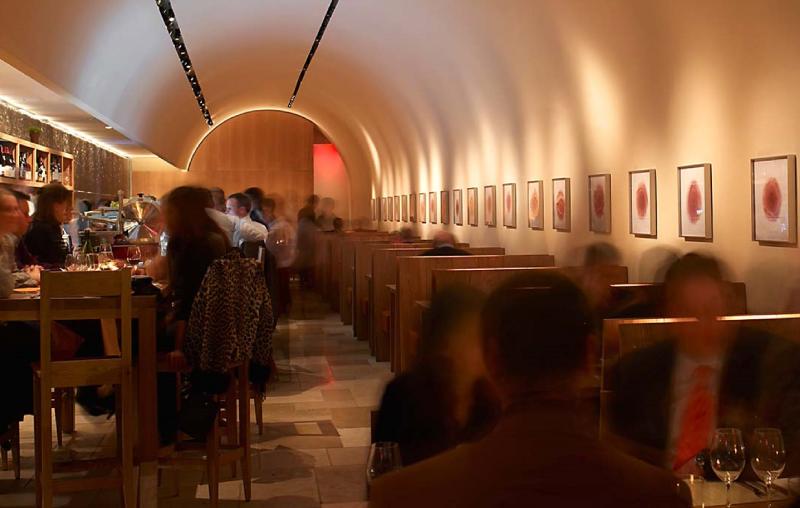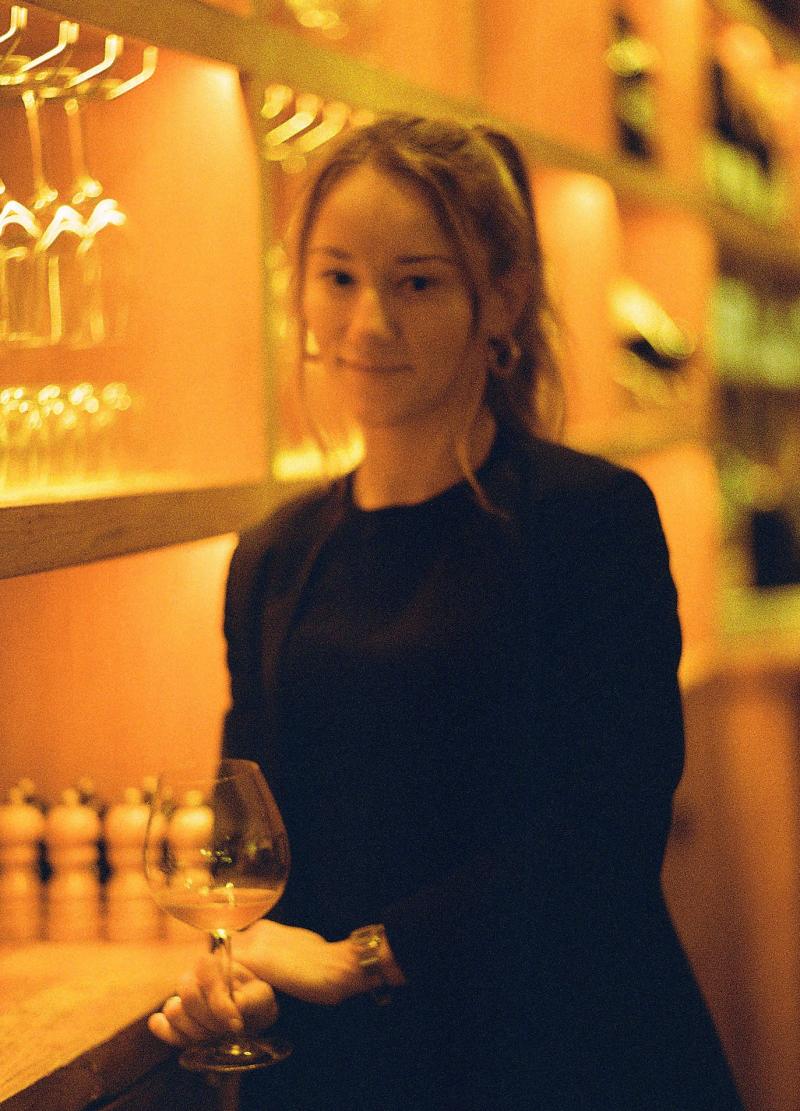Victoria Taylor is the head sommelier at the popular French restaurant Bar Boulud in N.Y.C., from Chef and Owner Daniel Boulud. The venue is directly across the street from Lincoln Center, and it features a relaxed environment, a seasonal Parisian menu, and a strong focus on wine – one that’s educational and accessible to all.
For this Q&A, Bar & Restaurant News spoke with Taylor to learn more about the wine program at Bar Boulud, to get her advice on creating a great wine menu, to discover some of her best practices for wine offerings at venues, and to learn how to avoid wine snobbery, among other topics.
A Trip to France Leads to a Career in French Food and Wine
Taylor, who grew up between New York and South Florida – with stays in California, Europe, and Asia sprinkled in – worked at a few local restaurants and diners during her teens. She found she enjoyed being a part of a collaborative team in the bar and restaurant industry, and then worked at restaurants and wine bars around Portland, Ore., during her college years. During that time, she learned about the importance of relationships with farmers and suppliers.
Initially planning on law school after college, Taylor decided to travel to France to learn more about food and wine, working with vintners in Burgundy and studying hospitality in Bordeaux. While in Bordeaux, she learned how to manage tastings, dinners, and parties, and she became more curious about French wine and food.
Following her post-grad ventures, Taylor joined Chef Boulud’s Dinex Group in September 2021, and then in early 2022, she was promoted to head sommelier of Bar Boulud and Boulud Sud, which both offer an impressive and unique wine list.
With her holistic approach to hospitality and exceptional service skills, Taylor integrates her understanding of the cultural and personal history to each bottle of wine. She said she loves creating great pairings for guests, as well as curating a selection of bottles from winemakers that have worked hard to produce, in her words, “such a magical thing.”

Bar & Restaurant News: Hi, Victoria! Thanks for your time. What can you tell us about Bar Boulud?
Victoria Taylor: Bar Boulud is a wine-focused, casual bistro on the Upper West Side of Manhattan, directly across the street from Lincoln Center. The restaurant is Chef Daniel Boulud’s homage to his childhood in the French countryside; a menu of seasonal, rustic French fare and a devotion to wine; our dining room mirrors wine caves in Burgundy, with a rounded tunnel-like ceiling and wood-colored booths.
Being so close to Lincoln Center means we’re a pre- and post-theater stop for folks attending shows at the Metropolitan Opera or New York Philharmonic, and allows us to devote a majority of our menu to an impressive selection of traditional terrines and pâtés that allow guests to construct anything from a table of snacks to a full, coursed meal.
What can you tell us about the wine offerings at Bar Boulud? And do you strive to have a wine menu that complements the food menu at the restaurant?
Our wine program, which was first conceived by Chef Boulud’s longtime partner-in-wine, Daniel Johnnes, is meant to be accessible and educational. The program is still mostly devoted to the regions surrounding Chef Boulud’s native Lyon, Burgundy, and the Rhône, but flexible and full of gems from other French Regions, Europe, and the U.S. Our by-the-glass offerings are ever-rotating and our bottle list is large – over 500 references with prices from $45 to $4,000.
Because our list is so large, it’s also filled with wines from throughout Europe and the United States; places with wines from places that I and our sommeliers love to drink.
I have a hard time with the platitude “what grows together goes together,” mostly because I’ve heard it more in situations where it doesn’t ring true. With that being said, I’ve found being confined to a regionally-influenced menu and wine list helps, especially when the food is traditional [such as the classic game pâté served with a smoky, Northern Rhône Syrah]. The first goal then is to find interesting, nuanced wines from those areas.
What advice do you have for restaurants and bars that want to elevate wine at their venue?
Figuring out what guests want is definitely important here – no matter how many expensive bottles or “unicorns” you have on the list, a majority of guests will shy away from a list that is both expensive and indecipherable. I like to track spending – if it seems like we’ve had a run on Meursault recently – as it’s a recognizable Burgundian village – I’ll look to add a few Meursault SKUs.
Create tight relationships with a few distributors. Allocations are pretty strict in New York, but even so, I find my relationships with import reps and portfolio managers are incredibly educational and lucrative.
What’s your best advice for creating a wine menu at a bar or restaurant?
Think about the food first; pairing is the most important when it comes to by the glass. I like my cheapest options to be the best overall pairings. At Bar Boulud, our cheapest white option is a Saumur Blanc that serves us well from charcuterie to red meat. So, in case the guest doesn’t want to spend a lot, at least they won’t leave with a bad taste in their mouth.
By-the-glass menus, at least at the beginning of their creation, shouldn’t be too esoteric or geeky, either. Having a skin-contact Gewurztraminer or super-natural Gamay can be fun and add levity to a glass list, as long as they’re surrounded by recognizable and traditionally made whites, reds, and roses.
What do’s and don’ts do you have for creating a really great wine menu?
Do add wine that you would drink. It’s hard to sell wine you’re not excited about. Allocate your budget for items that move quickly, first, then for the “cherries” and “unicorns” to pepper the list. Prioritize pairings – a small list can be a well-balanced complement to any menu; a larger list runs the risk of complaint. I generally find a “bad” pairing – like a rich red wine with white fish – has guests saying, “The wine was great! But the fish tasted weird…” I think it’s the sommelier’s job to make sure this does not happen.
Don’t add wine for the sake of appellation or variety. I would rather a list that had two really great Sangioveses that aren’t labeled Chianti than a list with a full and totally mediocre Chianti section. Don’t buy wine on dogma – while I believe that wine made from grapes grown biodynamically with low amounts of sulfur during production generally makes better wine, I don’t stick to only buying wines that fit that mold. Or any mold, really.

What’s the biggest mistake a restaurant or bar can make when creating a wine menu?
Trying to get as many big names and appellations on a list as possible. I see it here in New York often: A new restaurant opens up and has every Northern Rhone producer I can’t afford. A list like that doesn’t offer any personality or message or accessibility; its ultimately just boring.
What are customers looking for from a wine menu?
Oof, this is a tough one. Every guest is different, especially here at Bar Boulud where we have an array of guests. Those who come in especially for the wine list; they’ll talk to the sommeliers about wine for 10 minutes before deciding. Those who dine for the traditional French menu; they love recognizable Bordeaux and Burgundy. And those who just pop in before a show at Lincoln Center across the street; they generally get two glasses of the most recognizable by-the-glass option.
I think taking into account your location and ambitions are the most important [when creating a wine menu].
What type of restaurant or bar should have a wine sommelier and why?
A few! A restaurant with wines that require extensive service – decanting over light – should definitely have at least a server or manager who can carry out that duty. A restaurant that focuses heavily on wines should have someone available on the floor to guests who have questions – but more importantly to educate staff about what they offer. A restaurant with a big wine list – having a human present to take a guest through the wine list is important here, or else your Bordeaux, American Chardonnay, and Tuscan Red stock will diminish entirely.
If a restaurant or bar wants to have a wine menu, but they don’t want an extensive one, what should they do?
Whoever buys for the restaurant should definitely take into account pairings first – with a small list, the probability of a bad pairing runs much higher. Make sure all wines complement each dish a little.
When it comes to a food menu and how it relates to a wine menu, do you have any advice for other bar and restaurant operators/owners?
A great question! Well, if the goal of the restaurant is to sell more wine than food, then make the food simple and full of acid and salt, which wines generally like. My favorite meals have just been tapas-style food that we ordered to pair directly with our wines.
How can a restaurant or bar best cater to customers when it comes to wine, without veering into wine snobbery territory?
Guests should always feel comfortable ordering wine, even more comfortable when it’s a wine they’ve never had before. I believe education for servers and bartenders is key here – so long as the person serving the wine can humbly talk about what liquid is coming out of the bottle, the guest will feel some level of insurance between them and a name on a bottle they can’t pronounce.
Also, having a good breadth of price is important. At a business level, you can’t guarantee you’ll sell enough $200 to $500 bottles to cover a week’s cost anyway, so having those $75-ish bottles is important. It also doesn’t make a list seem totally skewed towards bigger spenders.

Is there anything unique you’re doing with your wine offerings/menu at Bar Boulud? What other creative ways is Bar Boulud celebrating or showcasing wine?
Yes! Mike Madrigale and Daniel Johnnes, the original wine-slingers here at Bar Boulud, started pouring glasses of wine out of large format bottles each night, and we haven’t stopped since. It’s a fun chance to taste some pretty rare bottles. For example, we’ll open a three liter of the super cult-y Chateau Yvonne Saumur Blanc and sell it at cost for $14/glass until it’s out. These large format pours bring in a lot of guests and revenue. We have a few regulars who dine at least once or twice a week when the large format seems interesting to them. It also provides the staff education on wines they’ll never work with in a by-the-glass program.
What wine trends are you paying attention to and why? And should bar and restaurant owners/operators even pay attention to wine trends?
I’m not really one for trends, but as I’m just a peon in the New York Market. I can’t say it’s possible to really exist in a wine market without paying attention to trends. Hopping on a trend can definitely be profitable and having one or two orange wines or Sicilian reds on a list definitely can’t hurt; I don’t think they should take up an entire list though.
As far as “natural” wines go, I’m not totally convinced. Wines that have a sense of place – or, the annoying word, “terroir” – and a message are more important to me, and I find that a lot of funky, natural wines lose nuance and detail in their production. This isn’t to say I don’t like all of them, but, on a whole, it does feel like a genuine movement that’s gone uber-trendy.
I’ve heard the term “Island Wines” a few times in the last year, and I’m all in on it. Wines from the Canary Islands, Corsica, Santorini, Crete, etc., are bright and salty and work well with an array of cuisine and dishes. I personally love what Ilihana Malihin is doing in Crete with a red grape called Liatiko – it’s savory and mineral and delicious.
Aaron Kiel, based in Raleigh, N.C., has worked in the beverage, tea and coffee industries for nearly two decades, as well as hospitality and technology. He’s a journalist and writer/reporter at heart, but he also wears a PR hat through his consultancy, ak PR Group. He works as the editor of World Tea News with Questex’s Bar & Restaurant Group, as well as a contributing writer for Bar & Restaurant News. He also sits on the advisory board for the annual World Tea Expo in Las Vegas, which is co-located with Bar & Restaurant Expo.
Are you registered for our Crave and Crave on the Menu newsletters? Sign up today!
Plan to Attend or Participate in the 2024 Bar & Restaurant Expo, March 18-20, 2024
To learn about the latest trends, issues and hot topics, and to experience and taste the best products within the bar, restaurant and hospitality industry, plan to attend Bar & Restaurant Expo 2024 in Las Vegas. Visit BarandRestaurantExpo.com.
To book your sponsorship or exhibit space at the 2024 Bar & Restaurant Expo, contact:
Veronica Gonnello (for companies A to G) e: [email protected] p: 212-895-8244
Tim Schultz (for companies H to Q) e: [email protected] p: 917-258-8589
Fadi Alsayegh (for companies R to Z) e: [email protected] p: 917-258-5174
Also, be sure to follow Bar & Restaurant on Facebook and Instagram for all the latest industry news and trends.
